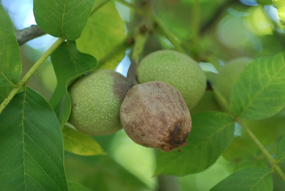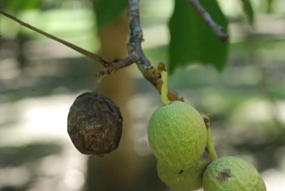Luke Milliron, UCCE Farm Advisor for Butte, Tehama, and Glenn Counties; Janine Hasey UCCE Farm Advisor, Sutter, Yuba, Colusa Counties; Themis Michailides, UC Davis Plant Pathologist, UC Kearney Research and Extension Center
Often in August, black to dark brown lesions (the blight phase) of Botryosphaeria or Phomopsis (Bot) infections start appearing on the hull from earlier, latent (symptomless) infections of the nut. Botryosphaeria can also cause cankers which can result from pruning wound infections and infections that move from blighted fruit or leaf scars into the spurs.
In research conducted by Themis Michailides, UC Davis Plant Pathologist at the Kearney Agricultural Research and Extension Center, winter pruning (February 9-10) resulted in higher infection rates than fall pruning (October 27-28).
- Dr. Michailides found in 2015 that when pruning in February, wounds in medium-to-large wood (3- and 4- year old branches) are susceptible to Botryosphaeria infection for at least four months after the pruning cut is made!
- Pruning wound infection rates were compared for winter vs. fall pruning. Pruning cuts were made in either February or October 2015, inoculated with Botryosphaeria spores, and evaluated over a year later (March 2016 and November 2016, respectively) for infection.
- Winter pruning resulted in infection rates (cankers in shoots) from 78 to 99 percent compared to 28 to 75 percent in fall pruned shoots.
- Higher infection rates were seen in three- and four-year old wood compared to one- and two-year old wood. These results further confirmed 2015 findings showing longer cankers in older wood. It is suspected that the hollow pith inside older walnut branches provides a haven for Botryosphaeria infection, spore germination, and pathogen growth. This long susceptibility may be because the pith holds water like a sponge.
Therefore, if pruning or hedging is planned this year, aim for as early in fall as you can and when weather is forecast to be dry. Deadwood removal however, is best done through the dry summer months.




Leave a Reply